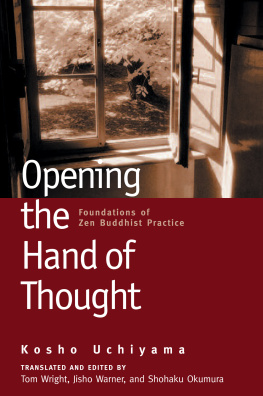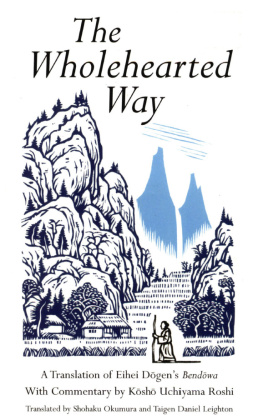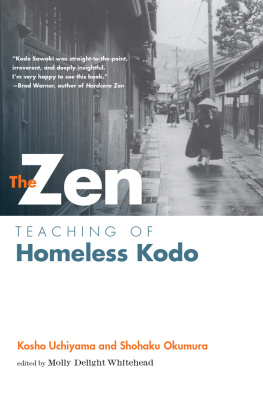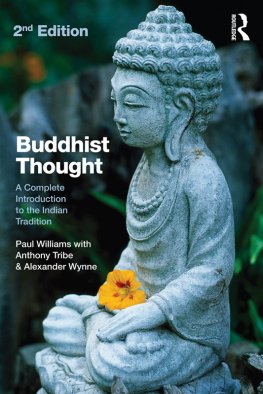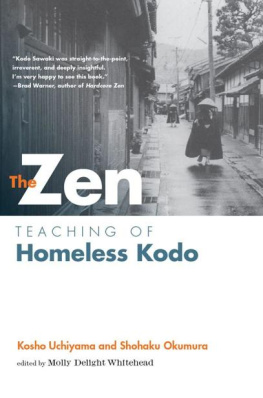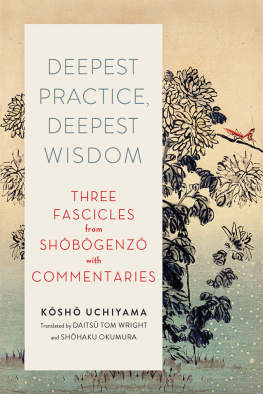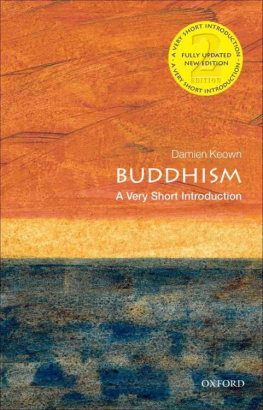Wisdom Publications
199 Elm Street
Somerville, MA 02144 USA
2004 by Jisho Warner
All rights reserved.
First Wisdom Edition
No part of this book may be reproduced in any form or by any means, electronic or mechanical, including photocopying, recording, or by any information storage and retrieval system or technologies now known or later developed, without permission in writing from the publisher.
Library of Congress Cataloging-in-Publication Data
Uchiyama, Ksh, 19121999
Opening the hand of thought : foundations of Zen buddhist practice / by Ksh Uchiyama ; translated and edited by Daitsu Tom Wright, Jisho Warner, Shohaku Okumura ; illustrations by Tai HazardRev. and expanded ed.
p. cm.
Includes bibliographical references and index.
ISBN 0-86171-357-5 (pbk. : alk. paper)
ISBN 978-0-86171-977-8 (ebook)
1. Spiritual lifeStsh. 2. StshDoctrines. I. Wright, Thomas, 1944 II. Warner, Jisho Cary. III. Okumura, Shohaku, 1948 IV. Hazard, Tai. V. Title.
BQ9438.U26 2004
294.3444dc22
2004004435
Cover design by Rick Snizik.
Interior design by Potter Publishing. Set in Diacritical Garamond 10.5/18.
Illustrations on pp. 79 by Ksh Uchiyama.
Additional illustrations by Tai Hazard.

To all who are practicing the buddhadharma
Sitting itself is the practice of the Buddha. Sitting itself is nondoing. It is nothing but the true form of the self. Apart from sitting, there is nothing to seek as the buddhadharma.
Eihei Dgen Zenji
ShbgenzZuimonki
(Sayings of Eihei Dgen Zenji)
Contents
6. Sit Silently for Ten Years

Prefaces

The Story of This Book and Its Author
by Jisho Warner
This is a very special book. Why does it deserve laurels, and your attention too? Opening the Hand of Thought goes directly to the heart of Zen practice. It describes the act of zazenwholeheartedly sitting in the middle of your lifewith great clarity and practicality. And it presents the wide, wide worldview that zazen opens up to you, showing how Zen Buddhism can be a deep and life-sustaining activity.
This book is a gift to us from one of the finest Zen masters, Ksh Uchiyama Roshi. Though he never set foot outside Japan, his mind and heart flew across the Pacific, he sent his disciples here to teach, and he taught a great many Westerners at Antaiji temple in Kyoto, where he was abbot for ten years.
Antaiji was a very unusual place for its mix of monks and lay people practicing together and its mix of Japanese and Westerners. Even more remarkably, it was purely for practicing zazen and investigating the meaning of life. Most monastic centers in Japan are primarily training places for licensing as a temple priest, but Uchiyama Roshi felt it was most important to practice without any expectation of a reward. He said that practice at Antaiji had no bite, that people needed to just practice for the sake of practice. Those disciples who needed certification as temple priests he sent to regular monasteries for supplementary training.
Uchiyama Roshis awareness of the West and his eagerness to make the Dharma and Zen practice available here, along with his background in Western philosophy and religion, meshed with his deep practice and understanding to create a unique voice. He lived by zazen, investigated with all his energy what it is to live a true life of Zen, and tells us about it in this book so we can delve into it for ourselves and verify the teachings for our own lives.
Zen is one long inquiry into how to live a truly full life. Life is universal, yet we feel separate from it and from each other. Taking what we need, discarding and preserving, enjoying and suffering, our life seems to be all about us. Uchiyama looks at what a person is, what a self is, how to develop a true self not separate from all things, one that can settle in peace in the midst of life. He dedicated his life to finding this out for himself and to passing it on to us, with great joy. Uchiyama Roshis teachings came directly out of his life, from his youthful idealism to his early years of poverty when he learned to digest discouragement and turn despair into equanimity, and then to the wisdom of his old age. What is most important is that this major contribution to Zen teaching and practice is now available to you, for your own life.
Opening the hand of thought is the very act of zazen. It is the original Buddhist practice of not grasping and clinging, the practice of freedom, as it occurs in this very moment in your mind. As the subtitle says, this book offers you a foundation of understanding, intention, and aspiration based on actually doing Zen practice. There was an earlier Opening the Hand of Thought . It has been revised here and the language clarified. We have added new prefaces, an index, and extended end notes.
We three translators have all been transformed by Uchiyama Roshis big mind. Shohaku Okumura was a young student when he met him. Okumura became his disciple and eventually settled in the United States to teach Zen. Daitsu Tom Wright went in the other direction, from Wisconsin to Kyoto, where he too became a disciple of Uchiyama Roshi. Wright stayed in Japan and was able to go on working with his teacher until Uchiyamas death in 1999. Jisho Warner first met Uchiyamas teachings in the United States as they began to take root here over twenty years ago. This book is a labor of love from Ksh Uchiyama and from the three of us.

Teacher and Disciple
by Shohaku Okumura
In 1965 when I was a seventeen-year-old high school student, a friend of mine went to Antaiji in Kyoto and stayed there for a few weeks for a special summer practice period for students. In the fall my friend told me all about his experience there, sitting zazen, listening to the old priests lectures and working with the young priest. He was particularly impressed by the way the young priest taught him how to make a fire, to keep the firewood burning well to heat water for the bath, and to extinguish the fire before the water became too hot. It was his first experience with a wood fire. He learned what being mindful and attentive means. The old priest was Kd Sawaki Roshi. The young priest was his disciple Ksh Uchiyama.
In June of that year, Uchiyama Roshi had published his book SelfJiko. I borrowed the book from my friend and became very interested in Uchiyama Roshis way of life. The next February my friend had surgery to deal with stomach pain he had had since the previous fall. He was very sick for a few more months and then he died. After his death, his mother told me that he had had intestinal cancer and, because he was young, the cancer grew very quickly. This friends death was one of the reasons I became a Buddhist priest. With his own death he showed me impermanence in actuality. He was a great teacher and bodhisattva for me.
I was very fortunate to encounter such a clear explanation of Zen practice in the very beginning of my practice. Even to a high school student like me, it was understandable. I began to see that our thoughts are the same as clouds. In our upright sitting all different kinds of thoughts come up, stay for a while, and disappear. We just let them come up and let them go away, not controlling our mind or preventing thoughts from coming up and passing away, not grasping or chasing after them either. We try to keep the same upright, immovable posture no matter what condition we are in, and to trust that above the clouds of thoughts, Buddhas wisdom and compassion are shining like the sun in a clear blue sky. This is what opening the hand of thought has come to mean in my life.
Next page
